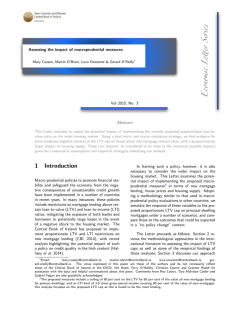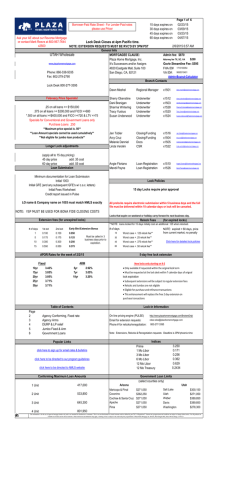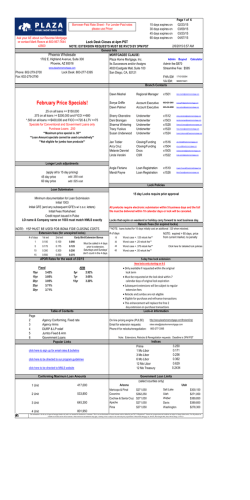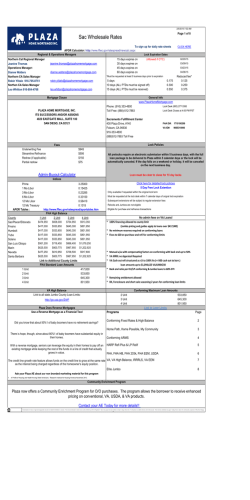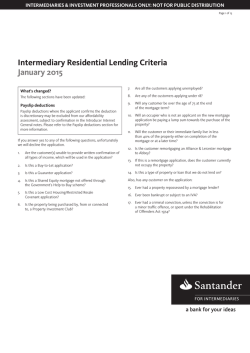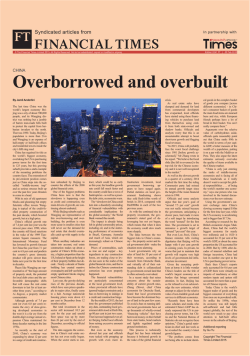
Information Note - Central Bank of Ireland
2015 Information Note: Restrictions on residential mortgage lending 1 Information note: Macro-prudential policy for residential mortgage lending Contents 1. 2. 3. 4. Introduction ............................................................................................ 2 Background to the Regulations .............................................................. 3 Scope of the measures ............................................................................ 4 LTV limits and exemptions .................................................................... 5 LTV limits ................................................................................................. 5 Exemptions to the LTV limits ..................................................................... 8 5. LTI limits and exemptions ................................................................... 11 LTI limits ................................................................................................. 11 Exemptions to LTI limits .......................................................................... 11 6. Monitoring and evaluation ................................................................... 12 Important information This note discusses Central Bank of Ireland (hereafter ‘Central Bank’) requirements in relation to residential mortgage lending as contained in the Central Bank (Supervision and Enforcement) Act 2013 ((Section 48)) Regulations 2015 (“Housing Loan Requirement”)1 (the Regulations). This Note is for information purposes only. It is not the policy of the Central Bank to provide legal advice on matters arising pursuant to the Regulations and any information in this note should not be construed as legal advice or a legal interpretation of the Regulations. It is a matter for any firm who may fall within the scope of the Regulations to seek legal advice regarding the application or otherwise of the Regulations to their particular set of circumstances. This note should not be taken as a substitute for legal advice. For further information, and avoidance of doubt, relevant entities should consult the applicable legal text directly. The Central Bank has a range of powers available to it in circumstances where a Firm fails to comply with the Regulations. Nothing in this Note may be construed so as to constrain the Central Bank from taking action where it is deemed to be appropriate. 1 S.I. No. X of 2015. 2 Information note: Macro-prudential policy for residential mortgage lending 1. Introduction The Central Bank is introducing Regulations which apply limits on the proportion of mortgage lending at high loan-to-value (LTV) and high loanto-income (LTI) ratios by regulated financial services providers in the Irish market. Key to the objectives of the Regulations and in accordance with the proper and effective regulation of regulated financial services providers is to increase the resilience of the banking and household sectors to the property market and to reduce the risk of bank credit and housing price spirals from developing in the future. The Central Bank does not wish to regulate or directly control housing prices. These measures are being introduced under Section 48 of the Central Bank (Supervision and Enforcement) Act 2013. These limits come into effect from the date of the making of the Regulations. The Regulations do not apply to switcher mortgages and housing loans for the restructuring of mortgages in arrears or pre arrears. LTV Limits There are different limits for different categories of buyers: Principal Dwelling Homes For non-first time buyers of primary dwelling homes (PDH): A limit of 80 per cent LTV applies on new mortgage lending. For first time buyers (FTBs) of PDHs: A limit of 90 per cent LTV applies on the first €220,000 of the value of a residential property and a limit of 80 per cent LTV applies on any value of the property thereafter. In this way, FTBs purchasing more expensive properties will be subject to a lower maximum LTV ratio than those purchasing cheaper properties. The total aggregate monetary amount of loans for principal dwelling purposes which breach either of these limits should not exceed 15 per cent of the total aggregate monetary amount of loans advanced for that purpose by a lender during the period from the effective date of these Regulations until 31 December 2015, and on an annual basis thereafter. Housing loans for borrowers in negative equity who wish to obtain a mortgage for a new property are not in scope of the LTV limits. As with all 3 Information note: Macro-prudential policy for residential mortgage lending these limits, this does not preclude a lender from applying stricter lending standards than contained in the Regulations. Buy to Lets (BTL) For non-primary dwelling home purchases: A limit of 70 per cent LTV applies, which should be exceeded by no more than 10 per cent of the total aggregate monetary amount of loans for non-PDH purposes, i.e., BTL mortgages. LTI Limits LTI limit: A LTI limit of 3.5 times gross annual income applies to all new lending for PDH purposes. This limit should be exceeded by no more than 20 per cent of the total aggregate monetary amount of loans for PDH purposes. The LTI limits do apply to borrowers in negative equity who wish to obtain a mortgage for a new property. Mortgages for non-PDH purposes, i.e., BTL mortgages, are exempt from the LTI limit. 2. Background to the Regulations The mandate of the Central Bank is to safeguard financial stability and protect consumers. The Central Bank also has an important role to play in macro-prudential policy. These policies aim to strengthen the resilience of the financial system and to reduce the potential for vulnerabilities that could lead financial distress to accumulate. There are many instruments at the Central Bank’s disposal which can contribute to these aims, as outlined in the Central Bank’s macro-prudential framework document2 and in the consultation paper CP873. For the rationale behind introducing LTV and LTI limits in Ireland, see CP87. These Regulations are complementary to existing micro-prudential supervision and to lenders’ own risk management practices. They are not intended to capture credit risk associated with the borrower, nor to replace or substitute for a lender’s existing internal credit assessment policies and 2 Central Bank of Ireland (2014), A macro-prudential policy framework for Ireland. Central Bank of Ireland (2014), Macro-prudential policy for residential mortgage lending, Consultation Paper CP87 3 4 Information note: Macro-prudential policy for residential mortgage lending procedures, but rather to reinforce and strengthen the existing suite of credit risk mitigation tools employed by prudent lenders. The introduction of the macro-prudential policy for residential mortgage lending does not obviate lenders’ responsibilities under the existing financial services legislative framework, and in particular, from the obligation to assess affordability and to lend responsibly on a case-by-case basis under the Consumer Protection Code. The Central Bank may, in future, consider it necessary to adjust any or all of the parameters of the proportionate LTV and LTI ratios in response to economic, market, or other developments. These adjustments could include, but not necessarily be limited to, the level of the LTV and / or LTI caps, the level of the proportionate caps, the scope of the Regulations and the exemptions applied. It is envisaged that such adjustments may be introduced without a lengthy period of prior public consultation and would be subject to consultation with the Minister for Finance. 3. Scope of the measures Subject to the (1) and (2) below, the Regulations apply to a housing loan that is secured on a residential property (a) that is entered into by a lender; (b) for which housing loan the borrower had not received an approval in principal based on a credit assessment supported by verified financial information before the effective date of these Regulations; and (c) where the relevant housing loan is secured on residential property in the State. The Regulations do not apply to: (1) ‘Switcher mortgages’, or refinancing of an existing housing loan; (2) Housing loans entered into for the purposes of addressing pre-arrears or arrears. 5 Information note: Macro-prudential policy for residential mortgage lending 4. LTV limits and exemptions LTV limits Lending for primary dwelling purposes The Central Bank considers a LTV limit of 80 per cent as an appropriate limit, taking into account international and other evidence and the specificities of the domestic market. It is considered that the macro-prudential aims of the objective can be achieved with a lower down-payment requirement for smaller loans to FTBs. While adding complexity to the policy, such a refinement responds to reasonable representations made in the consultation process.4 Many FTBs purchase lower value properties. However, this is not always the case and the application of a flat 90 per cent LTV limit for FTBs regardless of property value is not considered sufficient to meet a second objective of the Regulations, that of dampening the pro-cyclicality of property lending. With this in mind, the 90 per cent LTV limit will apply to first time buyers for any property value of up to €220,000 and an 80 per cent LTV limit will apply to any remaining value of a property thereafter. In this way, FTBs purchasing more expensive properties will be subject to a lower maximum LTV ratio than those purchasing cheaper properties. Thus, for example, for a FTB purchasing a property worth €300,000, the maximum loan allowed will be 90 per cent of €220,000 and 80 per cent of €80,000, giving a maximum LTV of 87.3 per cent. Given the prevalence (already discussed in CP87) of borrowers in negative equity at the time of drafting of the Regulations, households in this situation are deemed to be outside the scope of these LTV limits to avoid unduly limiting mobility for these borrowers. There is currently little new lending to these borrowers (less than 300 mortgages were issued by the main banks to borrowers in negative equity in 2014). Accordingly, it is not considered necessary at this time for macro-prudential purposes to introduce a special LTV regime for such borrowers. If unintended consequences or adverse behaviour is observed as a consequence of this exemption, or for any other reason it appears appropriate, the Central Bank reserves the right to amend the exemption accordingly. As with all these limits, this does not preclude a 4 It is also noted that, for first-time buyers, there is evidence of lower credit risk (cf. Kelly, R., O'Malley, T., & C. O'Toole, Do first-time buyers default less? Implications for macroprudential policy, Central Bank of Ireland Economic Letter, Vol 2014, No 14.). These borrowers are also on average more sensitive to down-payment constraints. 6 Information note: Macro-prudential policy for residential mortgage lending lender from applying stricter lending standards than contained in the Regulations. The Central Bank considers that a proportionate limit which would allow 15 per cent of new lending above the LTV cap is an appropriate balance between allowing sufficient flexibility yet maintaining prudent lending standards. Box 1: LTV limits for PDH lending For lending for primary dwelling home purposes: (a) For non-first time buyers, a maximum of 80 per cent LTV applies; (b) For first time buyers of properties valued up to and including €220,000, a maximum 90 per cent LTV limit will apply; (c) For first time buyers of properties valued over €220,000, a 90 per cent LTV limit will apply on the first €220,000 value of a property and an 80 per cent LTV limit will apply on any value of the property thereafter, in accordance with formula 1: Formula 1: For properties valued over €220,000: Effective FTB LTV cap = 80% + 10% (€220,000/Value of property) The total value of new lending for PDH purposes above these limits should be no more than 15 per cent of the euro value of all housing loans for PDH purposes entered into by a lender in an annual period. ( ) ( ) ( ) 7 Information note: Macro-prudential policy for residential mortgage lending Lending for non-primary dwelling home purchase Lending for non-primary dwelling home purchase can be considered more risky for the lender, all other things being equal, even though recovery of the collateral may be less problematic than for owner-occupied collateral. Central Bank research shows that BTL mortgages were more likely to be in arrears and finds evidence that negative equity had an important effect on trends in arrears.5 With this in mind, the Central Bank is requiring lenders to restrict new lending for non-primary dwelling purchase above 70 per cent LTV to no more than 10 per cent of the euro value of all housing loans for non-primary dwelling home purchase entered into in an annual period. Who do the LTV limits apply to? The limits apply to housing loans, approval in principal for which was received from the lender after the Regulations coming into effect, and the housing loan is secured on residential property in the State. For the avoidance of doubt, equity release / top up on an existing mortgage will be in scope of the Regulations. Different LTV limits apply depending on whether the borrower is: a) A non-first time buyer borrowing for a PDH; b) A first time buyer; or c) Borrowing for the purchases of a non-PDH (i.e. a buy to let). The LTV limits do not apply to refinancing of a housing loan (i.e. switcher mortgages) or housing loans entered into in order to address arrears or pre arrears. In addition, housing loans for borrowers in negative equity who wish to obtain a mortgage for a new property are not in scope of the LTV limits. A negative equity loan is an amount a borrower owes to a lender under a housing loan for a PDH where the relevant PDH has been sold and the proceeds from the sale have been insufficient to discharge in full the amounts that had been outstanding under the housing loan. Where the 5 Lydon, R., and Y. McCarthy (2011), What Lies Beneath? Understanding Recent Trends in Irish Mortgage Arrears, Central Bank of Ireland Research Technical Paper, No 14/RT/11. 8 Information note: Macro-prudential policy for residential mortgage lending borrower under a housing loan is more than one person, all borrowers will be regarded as borrowers under negative equity loans where any one or more of the persons under the housing loan is a borrower under a negative equity loan. A first time buyer is defined as a borrower to whom no housing loan has ever before been advanced. Where the borrower under a housing loan is more than one person and one or more of those persons has previously been advanced a housing loan, none of those persons is a first-time buyer. Exemptions to the LTV limits There are certain exemptions from these limits. The exemptions below do not count towards the total value of mortgages within the scope or the percentage limit and so are excluded from both the numerator and denominator in calculating compliance with the proportionate cap. 1. Negative equity borrowers: Borrowers in negative equity on a current property who are seeking a housing loan to finance a new property are out of scope of the LTV limits. 2. Switcher mortgages: re-mortgages on the same residential property with an amount that is the outstanding monetary balance at the date of the switch and not at origination (allowing for reasonable fees and costs associated with switching) are exempt from the LTV limits. 3. Mortgages in arrears: Alternative Repayments Arrangement or other options agreed with a borrower, the purpose of which is to resolve a borrower’s pre-arrears or arrears situation, are exempt from the limits. Information note: Macro-prudential policy for residential mortgage lending Box 2: Sliding limit for FTBs The LTV limit for FTBs depends on the value of the property being purchased. Properties valued at less than or equal to €220,000 will be subject to a maximum LTV of 90 per cent. For properties valued above this level, there is a maximum LTV ratio for each property value, which decreases as the property value increases (Figure 1 below). This is a prudent approach, which ensures that new lending to FTBs who are purchasing more expensive properties is at a lower maximum LTV ratio than those purchasing less expensive properties. For example, for a borrower purchasing a property worth €300,000, the maximum LTV allowed would be 87.3 per cent but for a borrower purchasing a property worth €600,000, the maximum LTV allowed would be 83.7 per cent. Figure 1: Maximum LTV limits for first time buyers 92% 90% 88% LTV 86% 84% 82% 80% 78% 50 100 150 200 250 300 350 400 450 500 550 600 650 700 750 800 850 900 950 1000 9 Property value (€, 000) Source: Central Bank calculations. The effect of this limit is different to a flat 80 per cent LTV limit for all FTBs. As 56 per cent of new FTB loans had a LTV above 80 per cent in the first half of 2014, an 80 per cent LTV limit would have affected over half of the number of new loans to FTBs in this period. The sliding LTV limit would have affected around 22 per cent of FTB loans in the same period. Of these borrowers, many would only have been marginally affected as almost 80 per cent of these were purchasing properties under €300,000 and thus they would have had to pay less than 3 per cent of an additional deposit. In general, FTBs buy lower-value properties. This can be seen in Figure 2, 10 Information note: Macro-prudential policy for residential mortgage lending which shows the distribution of house prices for new lending to FTBs in the first half of 2014. The median house price for a FTB was €182,000, and 57 per cent (84 per cent) of FTBs bought a property valued under €200,000 (€300,000) Figure 2: House price distribution for FTBs in 2014 Source: Central Bank of Ireland. 11 Information note: Macro-prudential policy for residential mortgage lending 5. LTI limits and exemptions LTI limits The Central Bank considers a limit of 3.5 times loan to gross annual income as a reasonable level for a LTI limit, taking into account international evidence and the specificities of the domestic market. The Central Bank considers that a proportionate limit which would allow 20 per cent of new lending above the LTI cap is an appropriate balance between allowing sufficient flexibility and maintaining prudent lending standards. Income means the total gross annual income, before tax or other deductions, of a borrower. Thus, the Central Bank is requiring lenders to restrict new lending for primary dwelling purchase above 3.5 times LTI to no more than 20 per cent of the euro value of all housing loans for principal dwelling home purposes entered into in a twelve month period. The limits apply to housing loans, approval in principal for which was received from the lender after the Regulations coming into effect, and the housing loan is secured on residential property in the State. For the avoidance of doubt, equity release / top up on an existing mortgage and borrowers under a negative equity loan are within the scope of the limits. The LTI limits do not apply to refinancing of housing loan (i.e. switcher mortgages) or housing loans entered into in order to address arrears or pre arrears. The LTI limits do not apply to housing loans for non-PDH purposes (i.e. buy –to- let). Exemptions to LTI limits The exemptions below do not count towards the total value of mortgages in scope or the percentage limit and so are excluded from both the numerator and denominator in calculating compliance with the proportionate cap. 1. Buy-to-let mortgages: these are not covered by the Regulations as the loan-to-income ratio is a less relevant metric for such lending. However, the more demanding LTV ceiling contributes towards limiting the risk for both borrower and lender. 12 Information note: Macro-prudential policy for residential mortgage lending 4. Switcher mortgages: re-mortgages on the same residential property with an amount that is the outstanding monetary balance at the date of the switch and not at origination (allowing for reasonable fees and costs associated with switching) are exempt from the LTI limits. 2. Mortgages in arrears: Alternative Repayments Arrangement or other options agreed with a borrower, the purpose of which is to resolve a borrower’s pre-arrears or arrears situation, are exempt from the limits. 6. Monitoring and evaluation Lenders will be required to submit data on their residential mortgage lending to the Central Bank via a specific monitoring template. The Central Bank intends to impose this reporting requirement pursuant to Section 22 of the Central Bank (Supervision and Enforcement) Act 2013. The monitoring template will require data at both granular and aggregate level. The granular data will take the form of a loan, borrower and collateral tape which is to be submitted in CSV format. Where a lender grants €50 million or more in residential mortgage lending in either reporting period (Jan - Jun or July - Dec) in a year, it will be required to submit a monitoring template to the Central Bank for that period and also at 31 December. Monitoring Templates will be required to be submitted to the Bank on two reporting dates. The reporting dates are (a) at 30 June each year to reflect activity in the 6 month period ending on that date and (b) annually at 31 December to reflect activity in the 12 month period ending on that date. It is the Central Bank’s intention to require that a preliminary aggregate level data submission must be submitted to the Central Bank within 10 working days of the reporting date. Within 20 working days of a reporting date a completed monitoring template including loan level data must be submitted to the Central Bank together with a final reconciling aggregatelevel data set. Data submitted shall be based on actual drawn loan amounts on an individual residential property basis. 13 Information note: Macro-prudential policy for residential mortgage lending The Central Bank will assess compliance with the Regulations on the basis of both the monitoring templates submitted by the lender. For the avoidance of doubt, there will be no carry over from one Annual Reporting Period to a subsequent Annual Reporting Period of any ‘un-used’ lending capacity within the proportionate exemptions specified in these regulations. The first Reporting Date will be 30 June 2015. The reporting period will be from the date the Regulations come into effect until 30 June 2015. Where a completed housing loan application was received by the lender in advance of the commencement of the Regulations, the Regulations will not apply to that housing loan.6 Lenders that advance less than €50 million in residential mortgage lending over a six month period are not required to submit a monitoring template to the Central Bank. All such lenders will be required to advise the Central Bank in writing of the total value of residential mortgage lending over the six month period within 10 working days of the end of each reporting date. 6 In order for a housing loan to be excluded from the scope of these Regulations the lender must, prior to the lender issuing an approval in principle, have undertaken a full credit assessment of the borrower’s ability to repay the housing loan. T +353 1 224 6000 www.centralbank.ie Bosca PO 559, Sráid an Dáma, Baile Átha Cliath 2, Éire PO. Box No 559, Dame Street, Dublin 2, Ireland
© Copyright 2025
